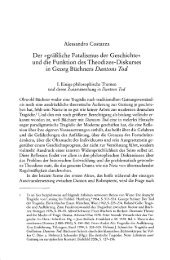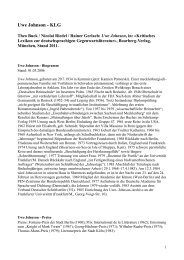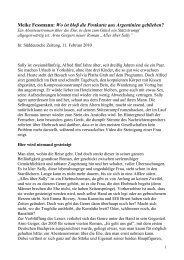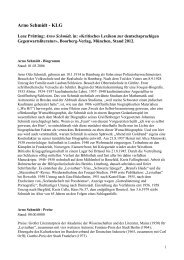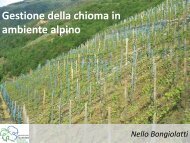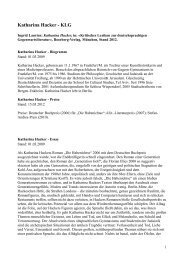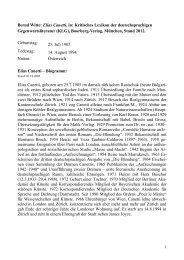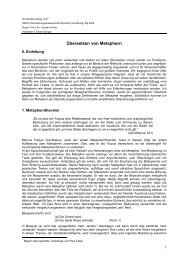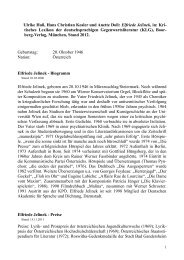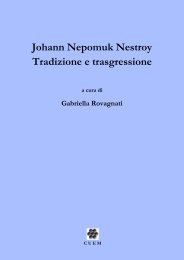Current Opinion in Investigational Drugs
Current Opinion in Investigational Drugs
Current Opinion in Investigational Drugs
Create successful ePaper yourself
Turn your PDF publications into a flip-book with our unique Google optimized e-Paper software.
30 <strong>Current</strong> <strong>Op<strong>in</strong>ion</strong> <strong>in</strong> <strong>Investigational</strong> <strong>Drugs</strong> 2006 Vol 7 No 1<br />
antipark<strong>in</strong>sonian agents. For example, data were recently<br />
presented <strong>in</strong> support of a protective action of rotigot<strong>in</strong>e<br />
whereby the progression of disability was attenuated <strong>in</strong> those<br />
patients with early-stage PD who received this agent [34].<br />
Conclusion<br />
In conclusion, the area of drug development <strong>in</strong> PD rema<strong>in</strong>s<br />
active and there is realistic hope of new therapies reach<strong>in</strong>g<br />
the market <strong>in</strong> the short to mid term.<br />
References<br />
1. Johnston TH, Brotchie JM: <strong>Drugs</strong> <strong>in</strong> development for Park<strong>in</strong>son's<br />
disease. Curr Op<strong>in</strong> Investig <strong>Drugs</strong> (2004) 5(7):720-726.<br />
2. Teva Pharmaceutical Ltd: Teva & Lundbeck announce phase III trials<br />
did not demonstrate etilevodopa superiority over standard<br />
levodopa. Press Release (2003):January 06.<br />
www.tevapharm.com/pr/2003/pr_371.asp<br />
3. Pfizer Inc: Pfizer announces the discont<strong>in</strong>uation of sumanirole<br />
development. F<strong>in</strong>ancial Report (2004) July.<br />
www.pfizer.com/pfizer/annualreport/2004/f<strong>in</strong>ancial/pr<strong>in</strong>t/r6.pdf<br />
4. Sethy VH, Ellerbrock BR, Wu H: U-95666E: A potential antipark<strong>in</strong>sonian<br />
drug with anxiolytic activity. Prog<br />
Neuropsychopharmacol Biol Psychiatry (1997) 21(5):873-883.<br />
5. Rascol O, Payoux P, Ory F, Ferreira JJ, Brefel-Courbon C, Montastruc<br />
JL: Limitations of current Park<strong>in</strong>son's disease therapy. Ann Neurol<br />
(2003) 53(Suppl 3):S3-S12; discussion S12-S15.<br />
6. DuChane J, Jenk<strong>in</strong>son C: Changes <strong>in</strong> quality of life result<strong>in</strong>g from<br />
treatment for persons with advanced Park<strong>in</strong>son's disease:<br />
Sumanirole versus placebo. International Congress on Park<strong>in</strong>son's<br />
Disease and Movement Disorders, Miami, FL, USA (2002):P309.<br />
7. Gomez-Mancilla B, Selzer K, Chapman K, Wang M, Simpson S:<br />
Sumanirole is a promis<strong>in</strong>g new agent <strong>in</strong> the treatment of<br />
Park<strong>in</strong>son's disease. International Congress on Park<strong>in</strong>son's Disease<br />
and Movement Disorders, Miami, FL, USA (2002):P323.<br />
8. Pearce RK, Smith LA, Jackson MJ, Banerji T, Scheel-Kruger J, Jenner<br />
P: The monoam<strong>in</strong>e reuptake blocker brasofens<strong>in</strong>e reverses<br />
ak<strong>in</strong>esia without dysk<strong>in</strong>esia <strong>in</strong> MPTP-treated and levodopa-primed<br />
common marmosets. Mov Disord (2002) 17(5):877-886.<br />
9. Hansard MJ, Smith LA, Jackson MJ, Cheetham SC, Jenner P: Dopam<strong>in</strong>e,<br />
but not norep<strong>in</strong>ephr<strong>in</strong>e or seroton<strong>in</strong>, reuptake <strong>in</strong>hibition reverses motor<br />
deficits <strong>in</strong> 1-methyl-4-phenyl-1,2,3,6-tetrahydropyrid<strong>in</strong>e-treated primates.<br />
J Pharmacol Exp Ther (2002) 303(3):952-958.<br />
10. Shire Pharmaceuticals Inc: Shire: A focused global pharmaceutical<br />
company. Focus<strong>in</strong>g on a bright future. Annual Review (2003).<br />
www.shire.com/shire/uploads/reports/AR_2003.pdf<br />
11. Hansard MJ, Smith LA, Jackson MJ, Cheetham SC, Jenner P: The<br />
monoam<strong>in</strong>e reuptake <strong>in</strong>hibitor BTS 74 398 fails to evoke<br />
established dysk<strong>in</strong>esia but does not synergise with levodopa <strong>in</strong><br />
MPTP-treated primates. Mov Disord (2004) 19(1):15-21.<br />
12. Neurosearch Inc: NeuroSearch's partner Boehr<strong>in</strong>ger Ingelheim has<br />
concluded the enrollment of patients <strong>in</strong> three cl<strong>in</strong>ical phase II<br />
studies with NS2330 for the treatment of Alzheimer's and<br />
Park<strong>in</strong>son's diseases. Annual Report (2004):November 09.<br />
http://neurosearch.com/pub/pdf/20041109_uk.pdf<br />
13. Sepracor Inc: Therapeutic areas: CNS, SEP-226330. Company Web Site<br />
(2005).<br />
http://www.sepracor.com/therap/sep226330.html<br />
14. Prestwick Pharmaceuticals Form S1. FORM S-1 (2005):April 22.<br />
15. GlaxoSmithKl<strong>in</strong>e Inc: GlaxoSmithKl<strong>in</strong>e announces phase III trial of<br />
controlled release rop<strong>in</strong>irole. Press Release (2005):April 12.<br />
http://science.gsk.com/pipel<strong>in</strong>e/pipel<strong>in</strong>e-march2005.pdf<br />
16. Stern MB, Marek KL, Friedman J, Hauser RA, LeWitt PA, Tarsy D,<br />
Olanow CW: Double-bl<strong>in</strong>d, randomized, controlled trial of rasagil<strong>in</strong>e<br />
as monotherapy <strong>in</strong> early Park<strong>in</strong>son's disease patients. Mov Disord<br />
(2004) 19(8):916-923.<br />
•• This paper describes one of two large studies demonstrat<strong>in</strong>g that oncedaily<br />
adm<strong>in</strong>istration of rasagil<strong>in</strong>e can significantly <strong>in</strong>crease the time dur<strong>in</strong>g<br />
which patients receive antipark<strong>in</strong>sonian benefit from L-DOPA without<br />
troublesome dysk<strong>in</strong>esia.<br />
17. Lew M, Hauser RA, Hurtig H, Ondo W, Wojcieszek J: Long-term efficacy of<br />
rasagil<strong>in</strong>e <strong>in</strong> Park<strong>in</strong>son's disease. Mov Disord (2005) 20:P250.<br />
•• The second of two large studies demonstrat<strong>in</strong>g that once-daily adm<strong>in</strong>istration of<br />
rasagil<strong>in</strong>e can significantly <strong>in</strong>crease the time dur<strong>in</strong>g which patients receive<br />
antipark<strong>in</strong>sonian benefit from L-DOPA without troublesome dysk<strong>in</strong>esia.<br />
18. Rascol O, Brooks DJ, Melamed E, Oertel W, Poewe W, Stocchi F, Tolosa E:<br />
Rasagil<strong>in</strong>e as an adjunct to levodopa <strong>in</strong> patients with Park<strong>in</strong>son's<br />
disease and motor fluctuations (LARGO, last<strong>in</strong>g effect <strong>in</strong> adjunct<br />
therapy with rasagil<strong>in</strong>e given once daily, study): A randomised, doublebl<strong>in</strong>d,<br />
parallel-group trial. Lancet (2005) 365(9463):947-954.<br />
19. Park<strong>in</strong>son Study Group: A randomized placebo-controlled trial of<br />
rasagil<strong>in</strong>e <strong>in</strong> levodopa-treated patients with Park<strong>in</strong>son disease and<br />
motor fluctuations: The PRESTO study. Arch Neurol (2005)<br />
62(2):241-248.<br />
20. Mandel S, We<strong>in</strong>reb O, Amit T, Youdim MB: Mechanism of<br />
neuroprotective action of the anti-Park<strong>in</strong>son drug rasagil<strong>in</strong>e and its<br />
derivatives. Bra<strong>in</strong> Res Bra<strong>in</strong> Res Rev (2005) 48(2):379-387.<br />
21. Hauser RA, Lew M, Hurtig H, Ondo W, Wojcieszek J: Early treatment<br />
with rasagil<strong>in</strong>e is more beneficial than delayed treatment start <strong>in</strong><br />
the long-term management of Park<strong>in</strong>son's disease. Mov Disord<br />
(2005) 20:P251.<br />
22. Mark MH: Long-term efficacy of istradefyll<strong>in</strong>e <strong>in</strong> patients with<br />
advanced Park<strong>in</strong>son's disease. Mov Disord (2005) 20:P310.<br />
23. Kyowa Hakko to focus on biotechnology. Pharma Jpn (2004) 1920: P6.<br />
24. Kyowa Hakko Kogyo Co Ltd: Overseas R&D activities. Company<br />
World Wide Web Site (2004):November 18.<br />
25. Biogen IDEC Inc: Vernalis and Biogen Idec to collaborate on<br />
research for Park<strong>in</strong>son's disease. Press Release (2004):June 24.<br />
http://biogen.com/news/BiogenIDECPR_045.htm<br />
26. Bara-Jimenez W, Bibbiani F, Morris MJ, Dimitrova T, Sherzai A,<br />
Mouradian MM, Chase TN: Effects of seroton<strong>in</strong> 5-HT1A agonist <strong>in</strong><br />
advanced Park<strong>in</strong>son's disease. Mov Disord (2005) 20(8):932-936.<br />
•• This study was the first demonstration <strong>in</strong> humans that 5HT1A agonists can<br />
reduce L-DOPA-<strong>in</strong>duced dysk<strong>in</strong>esia, and confirms f<strong>in</strong>d<strong>in</strong>gs from MPTPlesioned<br />
monkeys.<br />
27. EMD Pharmaceuticals: Sarizotan HCl <strong>in</strong> patients with Park<strong>in</strong>son's<br />
disease suffer<strong>in</strong>g from treatment-associated dysk<strong>in</strong>esia. (2005):August<br />
01.<br />
http://www.cl<strong>in</strong>icaltrials.gov/ct/show/NCT00105508<br />
28. Meco G, Fabrizio E, Epifanio A, Raimondo GD, Vanacore N, Morgante<br />
L: Levetiracetam <strong>in</strong> L-DOPA-<strong>in</strong>duced dysk<strong>in</strong>esia. Cl<strong>in</strong><br />
Neuropharmacol (2005) 28(2):102-103.<br />
29. Michel A, Ravenscroft P, Hill MP, Bezard E, Crossman AR, Klitgaard H:<br />
Seletracetam (UCB 44212) reduces L-DOPA-<strong>in</strong>duced dysk<strong>in</strong>esia <strong>in</strong><br />
the MPTP-lesioned marmoset model of Park<strong>in</strong>son's disease. Mov<br />
Disord (2005) 20:S102.<br />
30. Meissner W, Hill MP, Tison F, Gross CE, Bezard E: Neuroprotective<br />
strategies for Park<strong>in</strong>son's disease: Conceptual limits of animal models<br />
and cl<strong>in</strong>ical trials. Trends Pharmacol Sci (2004) 25(5):249-253.<br />
31. Amgen Inc: Follow<strong>in</strong>g complete review of phase 2 trial data Amgen<br />
confirms decision to halt GDNF study; Comprehensive review of<br />
scientific f<strong>in</strong>d<strong>in</strong>gs, patient safety, drove decision. Press Release<br />
(2005):February 11.<br />
http://www.amgen.com/media/media_pr_detail.jsp?year=2005&releaseI<br />
D=673490<br />
32. Lundbeck Inc: Cephalon and Lundbeck announce discont<strong>in</strong>uation of<br />
CEP-1347 cl<strong>in</strong>ical trial <strong>in</strong> Park<strong>in</strong>son's disease. Press Release<br />
(2005):May 11.<br />
http://www.lundbeck.com/<strong>in</strong>vestor/releases/ReleaseDetails/Release_158_<br />
EN.asp




